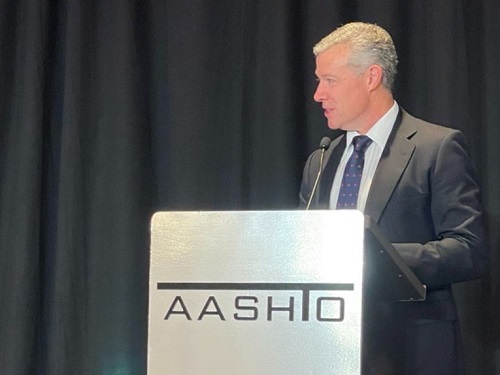The U.S. Department of Transportation issued $1.5 billion in grants via the Infrastructure for Rebuilding America or INFRA program on September 14 to support 26 highway, multimodal freight, and railroad projects across the country.
[Above photo by the Nevada DOT]
Known statutorily as the Nationally Significant Multimodal Freight and Highway Projects program, USDOT created INFRA in 2017 to advance a pre-existing grant program established by the Fixing America’s Surface Transportation or FAST Act of 2015. The agency updated the INFRA program with new project evaluation criteria to align them with national and regional economic vitality goals and to leverage additional non-federal funding, including public-private partnerships.

The $1.2 trillion Infrastructure Investment and Jobs Act or IIJA – enacted in November 2021 – increased funding for the INFRA program by more than 50 percent to help meet high demand for federal funding to support projects across the country. Over the next five years, the IIJA will provide approximately $8 billion for the INFRA program, including the $1.5 billion made available in this round of funding, USDOT noted in a statement.
The IIJA also expanded INFRA project eligibility to include, for example, wildlife crossings, marine highway corridors, and surface transportation projects located within or functionally connected to an international border crossing.
Additionally – thanks to a new, streamlined process created by the USDOT intended to reduce the burden on state and local entities – solicited applicants only had to submit one application for three different grant programs, including INFRA and two new programs: the Rural Surface Transportation Grant or RURAL program and the National Infrastructure Project Assistance or “Mega” program. The agency plans to announced recipients of RURAL and Mega grants in the coming months.
In addition to prioritizing projects that will deliver national or regional economic benefits, USDOT said it evaluated INFRA projects based on safety, how they supported freight movement and job creation, their efforts to address climate change and resiliency, impacts on equity and quality of life, how they applied innovative technology, their cost effectiveness, and demonstrated project readiness.
Further, USDOT awarded a significant amount of funding to rural areas, historically disadvantaged communities, and areas of persistent poverty to address historic underinvestment in these communities. Approximately 43 percent of awards will go to rural projects, exceeding the statutory requirement to award rural projects 25 percent of INFRA funding.
 Top Stories
Top Stories
State DOTs Call for Action at 2nd Annual Safety Summit
October 18, 2024 Top Stories
Top Stories

